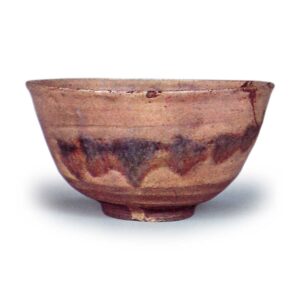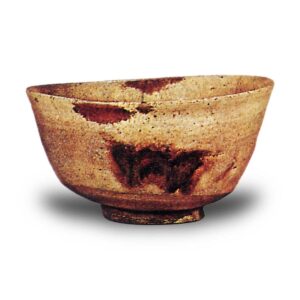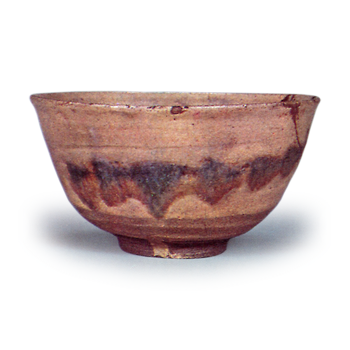

A tea bowl belonging to Soya Hakuan (1630-, died in the 7th year of Kan’ei, age 62), a medical official of the Shogunate, is called Hakuan, and the bowls made by him are called Hakuan. There are various theories as to its origin, including that it was made by the pottery founder Fujishiro, that it was made in Kiseto during the Rikyu period, or that it was made in Korea or China. There are ten traditional Hakuan oaths: 1) loquat color, 2) sea mouse glaze, 8) blotting, 4) half-moon shape, 5) crepe-dye, 6) wheel-formed, 7) kirazu clay (the base is the color of tofu), chamadori (the inside bottom of a tea bowl), 9) kokan-iri (a thin crack, or penetration, in the entire bowl), and edge warping (the edge of a tea bowl warps outward). (the mouth rim of the bowl is warped to the outside). In addition to the above, there are two more points: (1) the height of the bowl must have bamboo joints and (2) the bowl must have a flying glaze on the height of the bowl. According to a secret of the late master, when the bowl is turned down and viewed from the top, the base is off-center and to the side. The Fuyuki Hakuan in the collection of the Matsudaira family in Unshu has all of these thirteen promises. This type is rare, and there are seven types in “Kokin Meimono Ruiju”, seven types in “Meimono Chawan Shu”, sixteen types in “Chawan Meibutsu Zushu”, and eight types in “Taisho Meikikan”, all dating from the Manji Genbun era (1658-1741) of the Toda Yashichi family of Osaka. Some of the theories about Hakuan tea bowls are as follows: “Hakuan tea bowls were first named Sobo Hakuan in the Soya Hakuan family,” in the “Chamori Chachonen Moryosho” and “Gokusu Moryosho. There are three styles of Bishu Seto pottery: the loquat color of the ground, the Kumagawa style, and the fine texture of the soil when seen from the high ground. It is called namako yaku, which means “sea cucumber medicine” in Japanese, and the more medicine traces on it, the better it is. The shape is like Kumagawa’s, the height is different, the base is a light egg-colored, and the base is made with a small amount of milk, the clay is rough and the clay is light brown.
The drinking mouth is Kata-susumi, but Kata-susumi is the name of S Saito Soushuang outside of the drinking mouth.
It has the shape of a Hagi ware well-shaped tea bowl. The inside of the mouth is shaped as if it has been shaved, but the spatula is longer or shorter than the mouth. There is a thin piece of the base, and there is a word “Tobikomi” inside the base. There are two and three medicines of various sizes within the right side of the takadai, and there is also one medicine that has a mustard substance in it. The three medicines that are in evidence are not the same as the one used in Hakuan. There is also something called “raw sea squirt medicine,” which is found both inside and outside, and is not to be found anywhere else.
If there is a raw sea squirt, it is to be prized, but if there is none, it is to fall in rank. The price of the four Hakuan was 500 ryo. The “Wakan Meikiki Handbook” states, “Hakuan, a yellow Seto ware, came from the Sotani Hakuan family, hence its name. The yellow ameiyaku is a dark loquat color, and there is a raw sea squirt medicine at the waist, and a flying medicine inside and outside the base. It has seven teacups. They are made of sea cucumber medicine, flying medicine, white clay, loquat color, and bamboo joints on the incense stand, with a light brown tamenuri. It has fresh sea squirt medicine, and many of these are to be admired. The clay is white with some reddish tints, and the base is thin. There is also a Hakuan without raw sea squirt medicine, and there are many Hakuan that are made. It was taken out of the Edo city by a man named Sotani Hakuan, who was asked to see it when he was in Enshu’s reign and requested to have it inscribed with his name. The bowl of the right Hakuan was handed down to Lord Inaba, and it is said that this is the original poem. In Toda Teppen, “Hakuan was purchased from the family of Soshu Hakuan, and became the possession of Inaba Tango-no-mamoru-dono. In “Kogei Shiryo,” there is a Kiseto tea bowl made by a certain Fujishiro II, which is named Hakuan. In the Kan’ei era, there was a doctor of the shogunate named Sotani Hakuan, and he treasured it, so the people of the time called it Hakuan. He was a doctor in the Tokugawa shogunate during the Era of the Tokugawa Shogunate, and his works were treasured by the people of the time. The owner of the Sotani Hakuan warehouse passed it on to the Inaba clan, lords of the Odawara castle in Sagami Prefecture. In the “Chawanbiran” (Tea Utensils Handbook), it is written, “Koseto Hakuan, Hakuan was a disciple of Rikyu, a doctor, and a sukiya, and one day, when Rikyu requested a tea bowl, Hakuan, not finding it interesting at the time, took out a Koseto bowl and sent it to Rikyu, who treasured it and sent a tea bowl from it for his lifetime. In an article on the author at that time in the “Bessho Kichibei: A Man of Kawagoe in Bushu, Munehaku,” dated July 15, 1595, says, “Munehaku, a man of Kawagoe in Bushu, has recently come to Kyoto to bake tea containers with ears and has many tea bowls, and in Bushu, he is called Hakuan. In the “Appendix of Pottery Reviews,” there is a note that reads In the “Appendix of Pottery Reviews,” it is stated that Hakuan himself made tea bowls, “Hakuan of Kizeto is not commonly referred to as Sotani Hakuan’s work. The ceramic artifact is said to have been made in Yuezhou during the Tang dynasty (about a thousand years or more), and is called “Hakuan,” which means “grudge” in Chinese, and “Hakuan,” which means “Hakuan” in Chinese. Sotani Hakuan, who possesses Chinese Hakuan vessels, has mistakenly said that they are Hakuan from Koseto, but they must have copied this form from Seto, because the real thing is not seen by many people because it is kept in a large family. The tea bowl is said to be made by Fujishiro, and there is also a description in “Enbekiken” that “Hakuan-te” is a tea bowl made by Fujishiro, and “Kuwaniu” is also said to be a bowl made by Fujishiro, and “Hakuan-te” is a bowl made by Fujishiro, and “Hakuan-te” is a bowl made by Fujishiro, and there is a description in “Taisho Meiki-kan” that “This tea bowl was made by Fujishiro I and his family in the generation of Tozan-dono”, “This bowl is described in various tea ceremony books as being made by Fujishiro I and his family in the generation of Tozan-dono”. In the “Taisho Meiki-kan” (A History of Japanese Ceramics), “This tea bowl is said to have been made by Fujishiro I, but Kusama Waraaku’s “Meibutsu Zushu” (A Dictionary of Tea Ware) states that it was made in Kiseto in the Rikyu period. In “History of Japanese Ceramics” and “Koryo Chawan to Seto no Chajiryoku” (Koryo Tea Bowls and Seto Tea Containers), it is theorized that they were made in China, while Hara Bunjiro, in “Ceramics” Vol. 2, No. 2, argues for the Korean theory. In the “Taisho Meiki-kan” (Taisho Meikikan), he actually saw this piece and wrote as follows: “This is a thin piece with a small mouth rim. The body is covered with an alumite glaze, which is unique to Hakuan and measures 1.5″ in width and 7.8” in length. There are two vertical gutters, one long and one short, running from the mouth rim to the body, and the overall work is exquisite.



